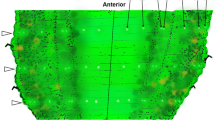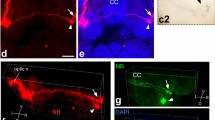Summary
The medicinal leech,Hirudo medicinalis possesses two types of photosensory organs: five bilateral pairs of eyes embedded in two longitudinal rows in the dorsal surface of the head, and seven bilateral pairs of sensilla situated in both the dorsal and the ventral surface of each of the 21 body segments. The photoreceptor cells of each eye or sensillum project their axons centrally via a characteristic cephalic or segmental nerve which carries the photosensory input to the brain or to the segmental ganglion. In response to a pulse of light the photoreceptors produce a train of impulses whose frequency first rises to anearly peak and then declines to asteady state plateau at which it remains until the end of the pulse. The amplitude of the early peak response and the level of the steady state plateau rise linearly with the log of the light pulse intensity, but the dynamic range of the early peak response is much narrower than that of the plateau. Both ocular and sensillar photoreceptors adapt to the intensity of interpulse background illumination; the ocular receptors adapt so completely that their level of background activity is nearly independent of the background light intensity, whereas the ventral sensillar photoreceptors adapt incompletely, so that their background activity rises with the background light intensity. Ocular and sensillar photoreceptors make their maximal response to green light at a wavelength of about 540 nm. They are almost insensitive to red and violet light at both extremes of the visible spectrum. The photosensory response of a single eye is directionally selective, whereas that of a single sensillum has much less directional selectivity. Several higher order sensory neurons were identified in the segmental ganglion that receive photosensory input from the sensilla. One of these neurons has the sensillum in the ipsilateral dorso-medial body wall of the same segment as its receptive field and another neuron the bilateral set of ventral sensilla in the body wall of the next posterior segment.
Similar content being viewed by others
References
Behrens, M.E., Wulff, V.J.: Light-initiated responses of retinula and eccentric cells in theLimulus lateral eye. J. gen. Physiol.48, 1081–1093 (1965)
Fioravanti, R., Fuortes, M.G.F.: Analysis of responses in visual cells of the leech. J. Physiol. (Lond.)227, 173–194 (1972)
Frank, E., Jansen, J.K.S., Rinvik, E.: A multisomatic axon of the leech. J. comp. Neurol.159, 1–14 (1975)
Fuortes, M.G.F., Poggio, G.F.: Transient responses to sudden illumination in cells of the eye ofLimulus. J. gen. Physiol.46, 435–452 (1963)
Gardner-Medwin, A.R., Jansen, J.K.S., Taxt, T.: The “giant” axon of the leech. Acta physiol. scand.87, 30A-31A (1973)
Gee, W.: The behavior of leeches with especial reference to its modifiability. Univ. Calif. Publ. Zool.11, No. 11, 197–305 (1912)
Graham, C.H., Hartline, H.K.: The response of single visual sense cells to light of different wave lengths. J. gen. Physiol.18, 917–931 (1935)
Guyer, M.F.: Animal micrology pp. 112. Chicago: University of Chicago 1953
Hanke, Ruth F.: The nervous system and the segmentation of the head in the Hirudinea. M.A. Thesis, Stanford University, 1948
Hansen, K.: Elektronenmikroskopische Untersuchungen der Hirudineen-Augen. Zool. Beitr. N.F.7, 83–128 (1962)
Herter, K.: Die Physiologie der Hirudineen. In: Bronn, H.G., Klassen und Ordnungen des Tierreichs 4, III,4, 321–496 (1936)
Hesse, R.: Untersuchungen über die Organe der Lichtempfindung bei niederen Tieren. III. Die Sehorgane der Hirudineen. Z. wiss. Zool.62, 247–283 (1897)
Kaiser, F.: Beiträge zur Bewegungsphysiologie der Hirudineen. Zool. Jb., Abt. allg. Zool.65, 59–90 (1954)
Laverack, M.S.: Mechanoreceptors, photoreceptors, and rapid conduction pathways in the leech,Hirudo medicinalis. J. exp. Biol.50, 129–140 (1969)
Lasansky, A., Fuortes, M.G.F.: The site of origin of electrical responses in visual cells of the leech,Hirudo medicinalis. J. Cell Biol.42, 241–252 (1969)
Livanow, N.: Untersuchungen zur Morphologie der Hirudineen. I. Das Neuro- und Myosomit der Hirudineen. Zool. Jb., Abt. Anat.19, 29–90 (1903)
Livanow, N.: Untersuchungen zur Morphologie der Hirudineen. II. Das Nervensystem des vorderen Körperendes und seine Metamerie. Zool. Jb., Abt. Anat.20, 153–226 (1904)
Mann, K.M.: Leeches (Hirudinea). Their structure, physiology, ecology, and embryology. New York: Pergamon Press 1962
Mystick, Diane: Rohde's fiber; a septate axon in the leech. Brain Res.74, 342–348 (1974)
Nicholls, J.G., Purves, D.: Monosynaptic chemical and electrical connections between sensory and motor cells in the central nervous system of the leech. J. Physiol. (Lond.)209, 647–667 (1970)
Norman, R.A., Werblin, F.S.: Control of retinal sensitivity. I. Light and dark adaptation of vertebrate rods and cones. J. gen. Physiol.63, 37–61 (1974)
Ort, C.A., Kristan, W.B., Jr., Stent, G.S.: Neuronal control of the swimming in the medicinal leech. II. Identification and connection of motor neurons. J. comp. Physiol.94, 121–154 (1974)
Röhlich, P., Török, L.J.: Elektronenmikroskopische Beobachtungen an den Sehzellen des Blutegels,Hirudo medicinalis. L. Z. Zellforsch.63, 618–635 (1964)
Schlüter, E.: Die Bedeutung des Centralnervensystems vonHirudo medicinalis für Locomotion und Raumorientierung. Z. wiss. Zool.143, 538–593 (1933)
Stuart, A.E.: Physiological and morphological properties of motoneurons in the central nervous system of the leech. J. Physiol. (Lond.)209, 627–646 (1970)
Walther, J.B.: Intracellular potentials from single cells in the eye of the leechHirudo medicinalis. Proc. XVI Internatl. Congr. Zool. Washington D.C. (1963)
Walther, J.B.: Single cell responses from the primitive eyes of an annelid. In: The functional organization of the compound eye (C.G. Bernhard, ed.), p. 329–366. Oxford: Pergamon Press 1966
Walther, J.B.: Widerstandsmessungen an Sehzellen des Blutegels,Hirudo medicinalis L. Verh. dtsch. zool. Ges.64, 161–164 (1970)
Whitman, C.O.: The leeches of Japan. Quart. J. micr. Sci., N.S.26, 317–416 (1886)
Author information
Authors and Affiliations
Additional information
We are indebted to Frank S. Werblin for valuable advice and discussions. We thank Kenneth L. Carlock for designing and constructing much of the special electronic equipment used in this study. We also thank Alexander Petruncola for his helpful suggestions regarding the computational analysis of the experimental results and for writing the computer programs used in the processing of the data.
This research was supported by Grant No. GB 31933X from the National Science Foundation, and NIH research grant No. GM 17866 and Training Grant No. GM 00829 from the Institute for General Medical Sciences.
Rights and permissions
About this article
Cite this article
Kretz, J.R., Stent, G.S. & Kristan, W.B. Photosensory input pathways in the medicinal leech. J. Comp. Physiol. 106, 1–37 (1976). https://doi.org/10.1007/BF00606569
Received:
Issue Date:
DOI: https://doi.org/10.1007/BF00606569




